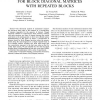Free Online Productivity Tools
i2Speak
i2Symbol
i2OCR
iTex2Img
iWeb2Print
iWeb2Shot
i2Type
iPdf2Split
iPdf2Merge
i2Bopomofo
i2Arabic
i2Style
i2Image
i2PDF
iLatex2Rtf
Sci2ools
107
Voted
CISS
2010
IEEE
2010
IEEE
Concentration of measure for block diagonal matrices with repeated blocks
Abstract—The theoretical analysis of randomized compressive operators often relies on the existence of a concentration of measure inequality for the operator of interest. Though commonly studied for unstructured, dense matrices, matrices with more structure are often of interest because they model constraints on the sensing system or allow more efficient system implementations. In this paper we derive a concentration of measure bound for block diagonal matrices where the nonzero entries along the main diagonal are a single repeated block of i.i.d. Gaussian random variables. Our main result states that the concentration exponent, in the best case, scales as that for a fully dense matrix. We also identify the role that the signal diversity plays in distinguishing the best and worst cases. Finally, we illustrate these phenomena with a series of experiments.
| Added | 23 Aug 2011 |
| Updated | 23 Aug 2011 |
| Type | Journal |
| Year | 2010 |
| Where | CISS |
| Authors | Christopher J. Rozell, Han Lun Yap, Jae Young Park, Michael B. Wakin |
Comments (0)

